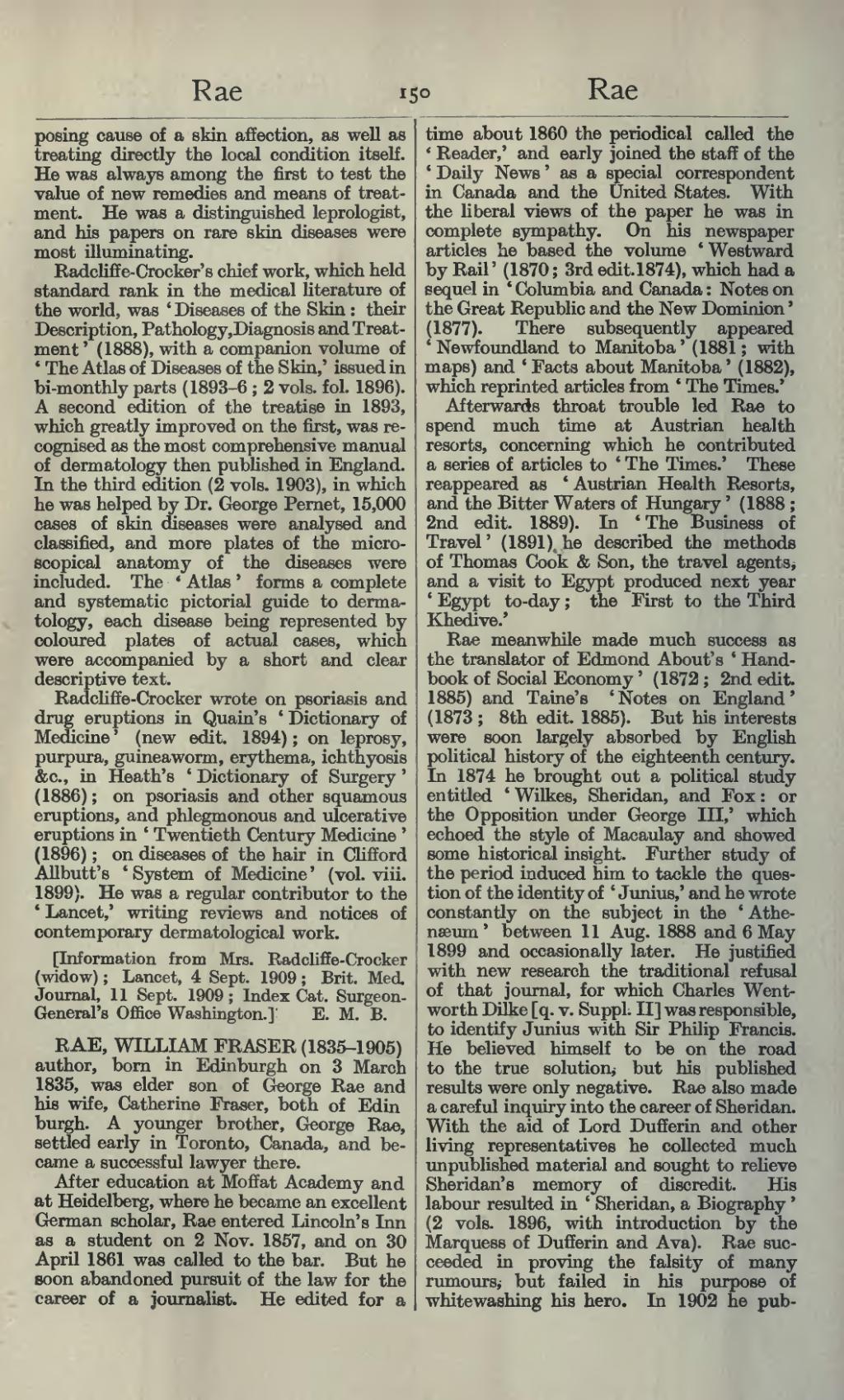posing cause of a skin affection, as well as treating directly the local condition itself. He was always among the first to test the value of new remedies and means of treatment. He was a distinguished leprologist, and his papers on rare skin diseases were most illuminating.
Radcliffe-Crocker's chief work, which held standard rank in the medical literature of the world, was 'Diseases of the Skin: their Description, Pathology,Diagnosis and Treatment' (1888), with, a companion volume of 'The Atlas of Diseases of the Skin,' issued in bi-monthly parts (1893-6; 2 vols. fol. 1896). A second edition of the treatise in 1893, which greatly improved on the first, was recognised as the most comprehensive manual of dermatology then published in England. In the third edition (2 vols. 1903), in which he was helped by Dr. George Pernet, 15,000 cases of skin diseases were analysed and classified, and more plates of the microscopical anatomy of the diseases were included. The 'Atlas' forms a complete and systematic pictorial guide to dermatology, each disease being represented by coloured plates of actual cases, which were accompanied by a short and clear descriptive text.
Radcliffe-Crocker wrote on psoriasis and drug eruptions in Quain's 'Dictionary of Medicine' (new edit. 1894); on leprosy, purpura, guineaworm, erythema, ichthyosis &c., in Heath's 'Dictionary of Surgery' (1886); on psoriasis and other squamous eruptions, and phlegmonous and ulcerative eruptions in 'Twentieth Century Medicine' (1896); on diseases of the hair in Clifford Allbutt's 'System of Medicine' (vol. viii, 1899). He was a regular contributor to the 'Lancet,' writing reviews and notices of contemporary dermatological work.
[Information from Mrs. Radchffe-Crocker (widow); Lancet, 4 Sept. 1909; Brit. Med. Journal, 11 Sept. 1909; Index Cat. Surgeon-General's Office Washington.]
RAE, WILLIAM FRASER (1835–1905) author, born in Edinburgh on 3 March 1835, was elder son of George Rae and his wife, Catherine Fraser, both of Edinburgh. A younger brother, George Rae, settled early in Toronto, Canada, and became a successful lawyer there.
After education at Moffat Academy and at Heidelberg, where he became an excellent German scholar, Rae entered Lincoln's Inn as a student on 2 Nov. 1857, and on 30 April 1861 was called to the bar. But he soon abandoned pursuit of the law for the career of a journalist. He edited for a time about 1860 the periodical called the ‘Reader,’ and early joined the staff of the ‘Daily News’ as a special correspondent in Canada and the United States. With the liberal views of the paper he was in complete sympathy. On his newspaper articles he based the volume ‘Westward by Rail’ (1870; 3rd edit. 1874), which had a sequel in ‘Columbia and Canada: Notes on the Great Republic and the New Dominion’ (1877). There subsequently appeared ‘Newfoundland to Manitoba’ (1881; with maps) and ‘Facts about Manitoba’ (1882), which reprinted articles from ‘The Times.’
Afterwards throat trouble led Rae to spend much time at Austrian health resorts, concerning which he contributed a series of articles to ‘The Times.’ These reappeared as ‘Austrian Health Resorts, and the Bitter Waters of Hungary’ (1888; 2nd edit. 1889). In ‘The Business of Travel’ (1891) he described the methods of Thomas Cook & Son, the travel agents, and a visit to Egypt produced next year ‘Egypt to-day; the First to the Third Khedive.’
Rae meanwhile made much success as the translator of Edmond About's ‘Handbook of Social Economy’ (1872; 2nd edit. 1885) and Taine's ‘Notes on England’ (1873; 8th edit. 1885). But his interests were soon largely absorbed by English political history of the eighteenth century. In 1874 he brought out a political study entitled ‘Wilkes, Sheridan, and Fox: or the Opposition under George III,’ which echoed the style of Macaulay and showed some historical insight. Further study of the period induced him to tackle the question of the identity of ‘Junius,’ and he wrote constantly on the subject in the ‘Athenæum’ between 11 Aug. 1888 and 6 May 1899 and occasionally later. He justified with new research the traditional refusal of that journal, for which Charles Wentworth Dilke was responsible, to identify Junius with Sir Philip Francis. He believed himself to be on the road to the true solution, but his published results were only negative. Rae also made a careful inquiry into the career of Sheridan. With the aid of Lord Dufferin and other living representatives he collected much unpublished material and sought to relieve Sheridan's memory of discredit. His labour resulted in ‘Sheridan, a Biography’ (2 vols. 1896, with introduction by the Marquess of Dufferin and Ava). Rae succeeded in proving the falsity of many rumours, but failed in his purpose of whitewashing his hero. In 1902 he pub-
